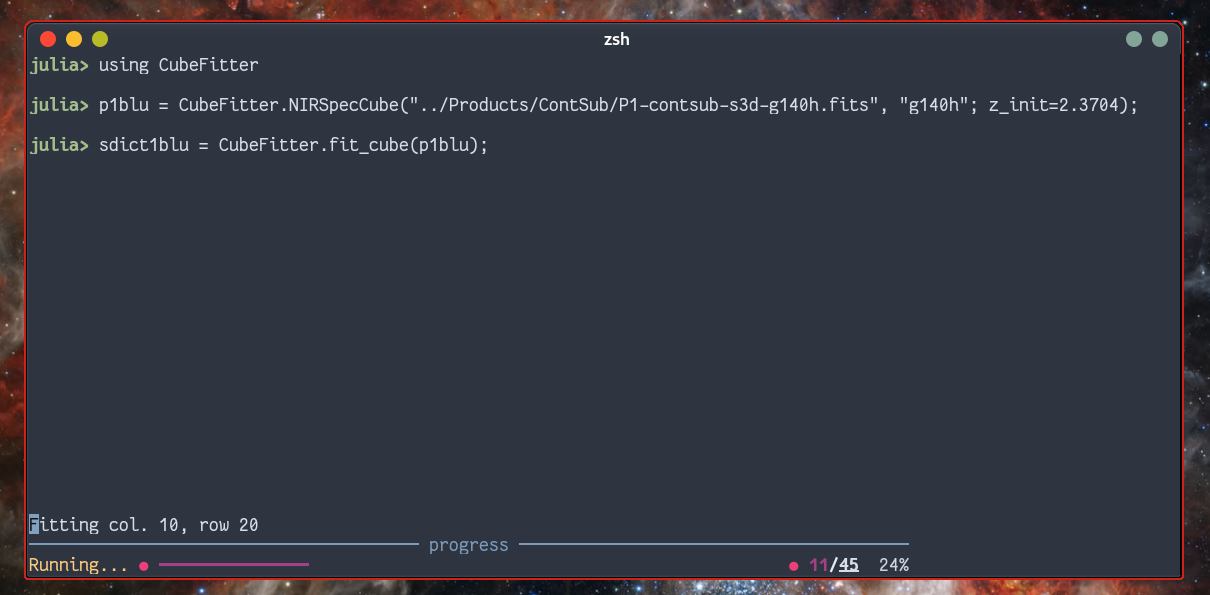A package for automatically fitting emission lines in astronomical spectral cubes. Hopefully, this could develop into a more general package for handling spectral cubes in Julia.
Development is still in early days, so everything may break - but currently, the NIRSpec related code Works For Me™. I am in the process of testing it for MIRI and MUSE, and most other instruments should be quite easy to add as well.
This code contains three main components (which may get separated into their own packages later):
- A family of
SpectralCubetypes which handle the data and metadata. - A continuum subtraction function (see description below)
- The functionality for fitting emission lines.
The workhorses of this package are the various types NIRSpecCube, MUSECube,
etc.; as well as the functions cont_subt(), fit_cube(), and
fit_spectrum_from_subcube().
This package is not yet registered to install (maybe later). To run it now, clone the repository to your preferred location; then:
julia> import Pkg
julia> Pkg.activate("/path/to/CubeFitter.jl")
julia> Pkg.instantiate() # Install dependencies, needs only be done once.
julia> using CubeFitterAlternatively, you can enter the Pkg> prompt, run activate /path/to/CubeFitter.jl,
then (first time) instantiate(). Press Backspace to return to the normal julia>
prompt, and run using CubeFitter.
A simple example of a session using CubeFitter.jl:
julia> cube = NIRSpecCube("/path/to/datacube.fits", "g140m"; z_init=2.43)
julia> cscube = cont_subt(cube)
julia> write_spectral_cube_to_fits("mycube.fits", cscube)
julia> out = fit_cube(cscube)
julia> write_maps_to_fits("/desired/path/to/output/file.fits", out)It is of course possible to just load the continuum subtracted cube and not go through that step again.
The function fit_cube() will return a dictionary of
The function fit_cube is mainly a convenience function enabling one to cycle through every
spaxel in the cube, and running the fits with default settings. One can also use the
function fit_spectrum_from_subcube() directly. This function allows to extract a
spectrum from the cube based on an x- and y range passed to it (this must always be a
range; if only one spaxel is wanted, give the range for the spaxel (i, j) as
xrange=i:i, yrange=j:j). The function extracts a simple, un-weighted spectrum over the
given (x, y) range, runs the fit, and return a dictionary of the fit results and
statistics, along with the extracted spectrum, errors, and wavelength range for
convenience. See the function docstring to learn more.
If nothing is specified in the call to fit_cube or
fit_spectrum_from_subcube, these functions will attempt to fit all lines in
the line list loaded along with the datacube, but will skip any that either is
outside the wavelength range of the cube, or has flux below the value of min_snr.
It is also possible to specify a list of lines to fit at the time of calling
these functions, with the optional argument line_selection, taking a list of
line names in String of Symbol format.
If no kinematic template lines are selected (see below), the lines in this list will be fitted simultaneously with shared kinematic parameters.
If kinematic template lines are specified, then the remaining lines will be modeled one by one.
the fit_cube function can as an optional argument take a list of lines to use
for a kinematics template. In this case, the lines of this list will first be
fit simultaneously as above. Afterwards, the remaining lines will be fit one by
one with their kinematics fixed to the one found from the template lines, and
the flux left as the only free parameters.
julia> cscube = NIRSpecCube("/path/to/cont_subtracted/datacube.fits", "g140m"; z_init=0.76)
julia> out = fit_cube(cscube, kinematics_from_lines=[:HI_4861, :OIII_4959, :OIII_5007])
julia> quicklook_slice(out, :OIII_5007, norm=sqrt, cmap=:inferno)NB! Lines that are part of blended features should be included in this list to be modeled properly, even if they are not particularly strong. I will implement something more elegant if I find the time (pull requests are always welcome!)
The function fit_cube() expects the data to already be continuum subtracted, but
otherwise saved in the same data format as the final pipeline products of a given
instrument; this can be done using the cont_subt() function as described above. Using
JWST/NIRSpec as an example, this means that the data cubes should be saved as a FITS file
with an empty primary HDU, and the flux and error cubes saved as the first and second
extensions, respectively. At the moment, this requirement is hardcoded, and any other
formats will either throw an error or, at worst, yield wrong and meaningless results.
CubeFitter includes three functions to quickly view fitting output for quality
control. See the docstings in the Julia REPL for documentation. The functions are:
-
quicklook_slice: Views the 2D line and kinematics maps output byfit_cube. -
quicklook_fit_result_dict: Previews the output of a single spectrum fit generated byfit_spectrum_from_subcube. -
quicklook_model: Previews a model generated by the functionbuild_model. See the docstrings of these functions for directions.
There really isn't much to look at but here it is:
In order of approximate priority:
- Include continuum subtraction functionality in the package.
- Make it possible to add a second and perhaps third kinematic component.
- Write quicklook-functions allowing to quickly view the fit outputs with minimum input. But still be tinker-friendly, don't hide stuff from the user.
- Create an interface to fix ratio between lines of doublets with shared upper levels.
- Create interface to select lines to always fit together (useful for blended features).
- Test and ensure the
MUSECubeandMIRICubestructs actually works as advertised - Allow for measuring flux or upper limits in lines that are currently excluded as having too low S/N ratio.
- Add support for more instruments. Suggestions welcome (especially if accompanied with a suitable test dataset).
